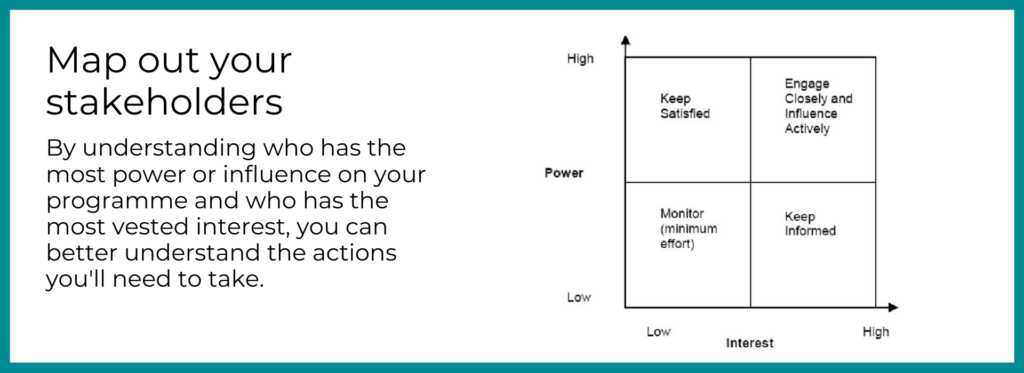“Segmentation has the power to be genuinely transformative for businesses. As such it can be tempting to present the findings in a huge launch event. In our experience, it’s much better to focus on bringing people with you throughout the process, slowly build anticipation, and demand.” Paul Carney
One of the key factors to a successful segmentation is having buy-in from senior stakeholders. When mapping out your stakeholders it is important not only to think about who has the biggest influence over your project in terms of approval or blocking, but also who has the biggest interest in your project. These are the individuals and teams who may be directly impacted by the implementation of insight. Typically segmentation can have a lot of stakeholder interest and so it can be somewhat difficult to ensure that everyone is heading in the same direction. This is why bringing in a third party may help to speed things along and keep people honest in terms of any deadlines or input that may be required.

When gathering your key stakeholders its crucial to clearly communicate a vision of what you want to achieve and the rationale behind this. People may find change uncomfortable, but they will accept it (or at least be more willing to accept it) if they if they can see the logic behind it. This can be greatly enhanced if you can point out how their own lives/jobs may directly improve as a result.
How will segmentation help different departments?
- Marketing – A better understanding of customers helps marketing to position your brand in places where they are more likely to get traction, to refine their messaging and to create campaigns which target specific people and their motivation for buying.
- Sales – Segmentation helps sales to narrow their focus on the customers that are more likely to convert. It allows for personalisation at scale and will improve the ROI of any sales activity.
- Customer Service – By understanding what brings customers into your category, you can better understand what will prevent them from churning. You can add more complexity to this by applying a propensity to churn model onto your database.
- Finance – Different types of shoppers will have different spending habits and understanding what is behind this can help with forecasting.
- Management – When you have business critical problems, its key to understand how your customers both current and future might respond and segmentation can help to inform you.
Segmentation is often a first step in work around new products or services. By understanding the priorities and questions different departments may have, it becomes easier to think about the data you’ll need to collect and the outputs of your work. Engage with your stakeholders throughout the programme and be clear when you’ll need their input and why, reinforcing that you are on a collective journey.
Best Practice
Source Channel, Content or Campaign: Can help you establish which themes and messages are more successful and which need more attention.
We strongly recommend having a point person within the business, for whom segmentation is a key part of their remit. We are starting to see job titles reflecting the importance of segmentation as a full-time, specialised insights role, similar to business intelligence, CX and innovation. This shifts the mindset away from segmentation being a defined project with fixed start & finish points, to more of a continuous, dynamic consumer understanding programme.
Getting an outside view can often help produce a segmentation programme which is quicker and fulfils your business needs. Why not talk to recognised industry leaders about your next programme? Contact us today.


